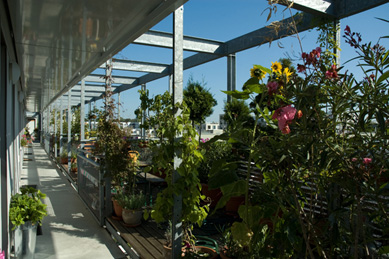Living in a leafy green area, yet in a central location, affordable housing for young and old and a tightly-knit neighbourhood network: Ackermannbogen in Munich is a newly created city district that is pleasant to live in.
Children are playing catch and football on the large open field between the adjacent rows of houses. The neighbourhood gets together in the adjoining Café Rigoletto. “How are you?“ says the waitress, greeting a young woman who is reading the newspaper at a sunny window seat. Ackermannbogen’s inhabitants know each other – their children go to the same schools and kindergartens, their paths cross several time a day, and they come together to represent their interests in one of the many citizens’ initiatives, the recreation rooms of which are open to all. The community barter network offers cookery and yoga courses, there are still some free places in the Musikgarten for young children, and the neighbourhood work association organises a media workshop for youngsters in the creative garage. There are probably few other districts in Munich that have such a vibrant, close-knit community network as Ackermannbogen. But that has not always been the case. Domestic culture and lifestyle have developed over time in the newly-built district. Fifteen years ago, the city set the course for the conversion project which was to develop the site of the former Waldmann and Stetten Barracks south of the Olympic Park into a residential and working district for 5,000 up to 6,000 people with some 500 jobs. So the new city district was planned on the drawing board in Schwabing-West, just three kilometres from the city centre. That meant that the inhabitants of the first section needed great imagination and pioneering spirit. Although many hopes and wishes were pinned on the emerging new city district, hardly anyone could imagine at first how it might turn out in the future. After the difficult early years when planning deficiencies emerged, such as a lack of schools, the overall concept of the city is now back on track, not least through civic involvement. Various municipal funding measures that awarded grants subsidising home ownership and rents led to the emergence of a new urban district with affordable housing at Ackermannbogen. Young and old, and in particular families who would have been forced out of Munich’s city centre to the periphery on account of the high rents, found a new home in the many new buildings.
A drop in the ocean
There is still evidence of gentrification problems in many parts of Munich, however. There is a general housing shortage in the city on the River Isar, affordable rented housing is generally scarce, especially in the city centre. Admittedly, in view of the growing need, Ackermannbogen with its 2,200 apartments is just a drop in the ocean. But the new district at least shows ways in which cities can counter the trend towards dying city centres and the expansion of urban commuter belts around the city. Planning is now under way for the site’s fourth and final construction phase. At last, the district is also going to get a supermarket. The site’s last southern tip will be lively, that is for sure. Some 40 per cent of the planned apartments are being developed by building cooperatives and community building groups. Such private house-building cooperatives have obvious advantages over profit-orientated property developers. The future inhabitants are already involved at the planning stage, discuss their future district with the city and want to achieve their ambitions with regard to the quality of their homes and their lives.
Different types of housing
Wedged between three thoroughfares and the Olympic Park, the district is visibly separated from other districts. A number of tall rows of buildings and residential blocks with up to 11 storeys form a framework for the arch-shaped site on the street-facing sides. In the area enclosed within, however, a varied and multifaceted world of different types and concepts of ideal housing opens up. Classical-style residential buildings, bright one-family and split-level homes and wooden buildings are gathered around a central green axis. Some rows are equipped with solar cells on the roof, or linked up with a heat accumulator and central power centre. Play areas and leafy arcades, joint courtyards and private verandas open up inside toward the green areas. Various residential forms, such as multigenerational housing, housing cooperatives and rows of houses with their own gardens, are concentrated in this nearly carless urban district. Only a few of the streets in the reduced traffic areas are even fit for traffic. There are cellars underneath about 80 per cent of the total area, some of which are used as garages. “None of us here has a car,“ says the waitress at Café Rigoletto in parting. “We live in the city, we don’t need one. And if you ever do, there is a car-sharing station here in the district.“ In Ackermannbogen, you can live in a leafy green area in the city centre largely free of exhaust fumes, traffic and noise. This is a model that may turn out to be a blueprint for the future if the inhabitants do their bit.
Text: Sandra Hofmeister

